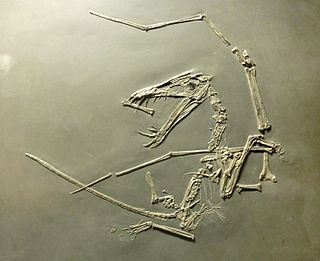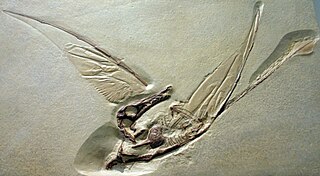
Pterosaurs are an extinct clade of flying reptiles in the order Pterosauria. They existed during most of the Mesozoic: from the Late Triassic to the end of the Cretaceous. Pterosaurs are the earliest vertebrates known to have evolved powered flight. Their wings were formed by a membrane of skin, muscle, and other tissues stretching from the ankles to a dramatically lengthened fourth finger.

Rhamphorhynchus is a genus of long-tailed pterosaurs in the Jurassic period. Less specialized than contemporary, short-tailed pterodactyloid pterosaurs such as Pterodactylus, it had a long tail, stiffened with ligaments, which ended in a characteristic soft-tissue tail vane. The mouth of Rhamphorhynchus housed needle-like teeth, which were angled forward, with a curved, sharp, beak-like tip lacking teeth, indicating a diet mainly of fish; indeed, fish and cephalopod remains are frequently found in Rhamphorhynchus abdominal contents, as well as in their coprolites.

Anurognathus is an extinct genus of small pterosaur from the Late Jurassic Altmühltal Formation of Germany.

Dorygnathus was a genus of rhamphorhynchid pterosaur that lived in Europe during the Early Jurassic period, when shallow seas flooded much of the continent. It had a short wingspan, and a relatively small triangular sternum, which is where its flight muscles attached. Its skull was long and its eye sockets were the largest opening therein. Large curved fangs that "intermeshed" when the jaws closed featured prominently at the front of the snout while smaller, straighter teeth lined the back. Having two or more morphs of teeth, a condition called heterodonty, is rare in modern reptiles but more common in basal ("primitive") pterosaurs. The heterodont dentition in Dorygnathus is consistent with a piscivorous (fish-eating) diet. The fifth digit on the hindlimbs of Dorygnathus was unusually long and oriented to the side. Its function is not certain, but the toe may have supported a membrane like those supported by its wing-fingers and pteroids. Dorygnathus was according to David Unwin related to the Late Jurassic pterosaur Rhamphorhynchus and was a contemporary of Campylognathoides in Holzmaden and Ohmden.
Comodactylus is a genus of "rhamphorhynchoid" pterosaur from the Kimmeridgian-Tithonian-age Upper Jurassic Morrison Formation of Wyoming, United States, named for a single wing metacarpal.

Campylognathoides is an extinct genus of pterosaur discovered in the Württemberg Lias deposits of Germany; this first specimen however, consisted only of wing fragments. Further better preserved specimens were found in the Holzmaden shale; based on these specimens, Felix Plieninger erected a new genus.

Angustinaripterus was a basal pterosaur, belonging to the breviquartossan family Rhamphorhynchidae and discovered at Dashanpu near Zigong in the Sichuan province of China.

Parapsicephalus is a genus of long-tailed rhamphorhynchid pterosaurs from the Lower Jurassic Whitby, Yorkshire, England. It contains a single species, P. purdoni, named initially as a species of the related rhamphorhynchid Scaphognathus in 1888 but moved to its own genus in 1919 on account of a unique combination of characteristics. In particular, the top surface of the skull of Parapsicephalus is convex, which is otherwise only seen in dimorphodontians. This has been the basis of its referral to the Dimorphodontia by some researchers, but it is generally agreed upon that Parapsicephalus probably represents a rhamphorhynchid. Within the Rhamphorhynchidae, Parapsicephalus has been synonymized with the roughly contemporary Dorygnathus; this, however, is not likely given the many differences between the two taxa, including the aforementioned convex top surface of the skull. Parapsicephalus has been tentatively referred to the Rhamphorhynchinae subgrouping of rhamphorhynchids, but it may represent a basal member of the group instead.
Kepodactylus is an extinct genus of ctenochasmatid pterodactyloid pterosaur from the Kimmeridgian-Tithonian-age Upper Jurassic Morrison Formation of Colorado, United States.

Nurhachius is a genus of istiodactylid pterodactyloid pterosaur from the Barremian to Aptian-age Lower Cretaceous Jiufotang Formation of Chaoyang, Liaoning, China. Its fossil remains date back about 120 million years ago.
Longchengpterus, sometimes misspelled as "Lonchengopterus", is a genus of istiodactylid pterodactyloid pterosaur from the Barremian-Aptian-age Lower Cretaceous Jiufotang Formation of Chaoyang, Liaoning, China. Its fossil remains dated back about 120 million years ago.
Utahdactylus was a genus of extinct reptile from the Kimmeridgian-Tithonian-age Upper Jurassic Morrison Formation of Utah, United States. Based on DM 002/CEUM 32588, Czerkas and Mickelson (2002) identified it as a "rhamphorhynchoid" pterosaur. Bennett (2007) later concluded that it has no diagnostic features of the Pterosauria, and cannot be positively identified beyond being an indeterminate diapsid. More recent work on newly prepared material, however, seems to confirm once again that Utahdactylus was a pterosaur.
Changchengopterus is a genus of non-pterodactyloid pterosaur from Qinglong County in Hebei Province, China.

Pterosaurs included the largest flying animals ever to have lived. They are a clade of prehistoric archosaurian reptiles closely related to dinosaurs. Species among pterosaurs occupied several types of environments, which ranged from aquatic to forested. Below are the lists that comprise the smallest and the largest pterosaurs known as of 2022.

Rhamphorhynchidae is a group of early pterosaurs named after Rhamphorhynchus, that lived in the Late Jurassic. The family Rhamphorhynchidae was named in 1870 by Harry Govier Seeley. Members of the group possess no more than 11 pairs of teeth in the rostrum, a deltopectoral crest that is constricted at the base but expanded at the distal end, and a bent phalange on the fifth toe.

Bellubrunnus is an extinct genus of rhamphorhynchid pterosaur from the Late Jurassic of southern Germany. It contains a single species, Bellubrunnus rothgaengeri. Bellubrunnus is distinguished from other rhamphorhynchids by its lack of long projections on the vertebrae of the tail, fewer teeth in the jaws, and wingtips that curve forward rather than sweep backward as in other pterosaurs.

Kryptodrakon is an extinct genus of pterodactyloid pterosaur from the Middle to Late Jurassic with an age of approximately 162.7 million years. It is known from a single type species, Kryptodrakon progenitor. The age of its fossil remains made Kryptodrakon the basalmost and oldest pterodactyloid known to date.

Allkaruen is a genus of "rhamphorhynchoid" pterosaur from the Early Jurassic Cañadon Asfalto Formation in Argentina. It contains a single species, Allkaruen koi.

Douzhanopterus is an extinct genus of monofenestratan pterosaur from the Late Jurassic of Liaoning, China. It contains a single species, D. zhengi, named by Wang et al. in 2017. In many respects, it represents a transitional form between basal pterosaurs and the more specialized pterodactyloids; for instance, its tail is intermediate in length, still being about twice the length of the femur but relatively shorter compared to that of the more basal Wukongopteridae. Other intermediate traits include the relative lengths of the neck vertebrae and the retention of two, albeit reduced, phalanx bones in the fifth digit of the foot. Phylogenetically, Douzhanopterus is nested between the wukongopterids and a juvenile pterosaur specimen from Germany known as the "Painten pro-pterodactyloid", which is similar to Douzhanopterus in many respects but approaches pterodactyloids more closely elsewhere.
Ceoptera is an extinct genus of darwinopteran pterosaur from the Middle Jurassic Kilmaluag Formation of Scotland. The genus contains a single species, C. evansae, known from a partial skeleton. Ceoptera represents the second pterosaur named from Scotland, after Dearc in 2022.




























